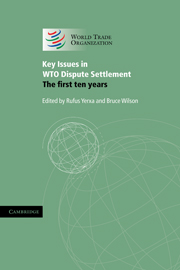Book contents
- Frontmatter
- Contents
- Notes on contributors
- Preface
- Table of cases
- Abbreviations
- PART I Introduction and General Considerations
- PART II The WTO Dispute Settlement System: Its Processes and Its Institutions
- 3 The WTO dispute settlement system and its operation: a brief overview of the first ten years
- 4 The role of the Dispute Settlement Body in the dispute settlement process
- 5 Consultations and the panel process in the WTO dispute settlement system
- 6 Contingent trade remedies and WTO Dispute Settlement: some particularities
- 7 The making of the ‘World Trade Court’: the origins and development of the Appellate Body of the World Trade Organization
- 8 Special challenges at the appellate stage: a case study
- 9 The reasonable period of time for compliance with rulings and recommendations adopted by the WTO Dispute Settlement Body
- 10 Implementation of panel and Appellate Body rulings: an overview
- 11 A brief introduction to countermeasures in the WTO dispute settlement system
- PART III The WTO Dispute Settlement System: Systemic and Other Issues
- PART IV Annexes
3 - The WTO dispute settlement system and its operation: a brief overview of the first ten years
from PART II - The WTO Dispute Settlement System: Its Processes and Its Institutions
Published online by Cambridge University Press: 04 August 2010
- Frontmatter
- Contents
- Notes on contributors
- Preface
- Table of cases
- Abbreviations
- PART I Introduction and General Considerations
- PART II The WTO Dispute Settlement System: Its Processes and Its Institutions
- 3 The WTO dispute settlement system and its operation: a brief overview of the first ten years
- 4 The role of the Dispute Settlement Body in the dispute settlement process
- 5 Consultations and the panel process in the WTO dispute settlement system
- 6 Contingent trade remedies and WTO Dispute Settlement: some particularities
- 7 The making of the ‘World Trade Court’: the origins and development of the Appellate Body of the World Trade Organization
- 8 Special challenges at the appellate stage: a case study
- 9 The reasonable period of time for compliance with rulings and recommendations adopted by the WTO Dispute Settlement Body
- 10 Implementation of panel and Appellate Body rulings: an overview
- 11 A brief introduction to countermeasures in the WTO dispute settlement system
- PART III The WTO Dispute Settlement System: Systemic and Other Issues
- PART IV Annexes
Summary
Introduction
The WTO dispute settlement system plays a central role in clarifying and enforcing the legal obligations contained in the various WTO agreements. It is generally agreed among WTO Members that the WTO dispute settlement system has functioned reasonably well in its first ten years, although the jurisprudence emanating from this system has not been without its critics from both the public and private sectors of a large cross-section of the WTO membership. The purpose of this chapter, however, is not to analyse or comment on the jurisprudence that the system has produced; such analysis and commentary must be left to the Members themselves and to legal scholars and commentators. Rather, the purpose of this chapter is to provide a brief overview of the system and how it has operated in the first ten years of its existence (1995–2004), including the extent to which the system has been used by Members; the nature of the cases brought to the system; and Members' compliance record with respect to adverse panel and Appellate Body reports.
The WTO dispute settlement system is codified in the Understanding on Rules and Procedures Governing the Settlement of Disputes (Dispute Settlement Understanding or DSU), which was arguably one of the most important agreements negotiated during the Uruguay Round. The DSU is based on, but significantly expanded, GATT dispute settlement law and practice.
- Type
- Chapter
- Information
- Key Issues in WTO Dispute SettlementThe First Ten Years, pp. 15 - 24Publisher: Cambridge University PressPrint publication year: 2005



